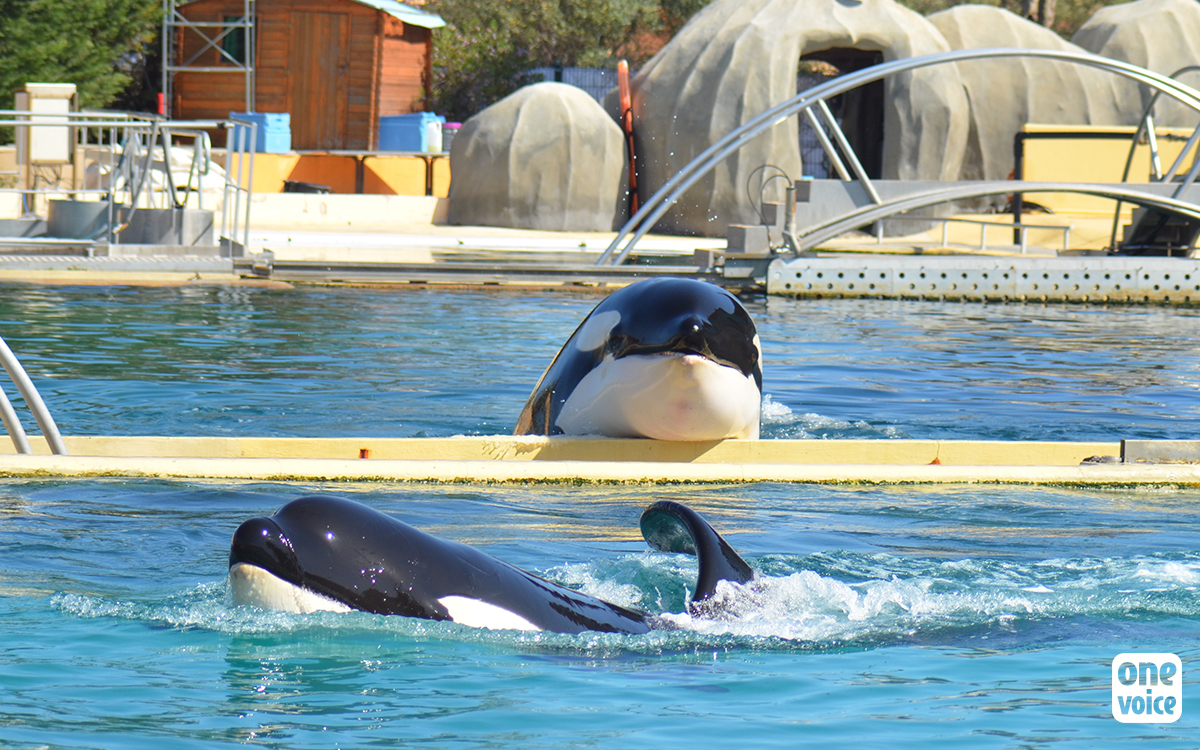

Lettre d'Ingrid Visser et de spécialistes aux ambassadeurs pour interdire l'import d’animaux sauvages vers la Chine, Orcinus orca, potentiels vecteurs
En soutien à la campagne de One Voice, la biologiste Ingrid Visser et un groupe d’experts interpelle les ambassadeurs de Chine et de France et des États-Unis en Chine pour plaider la cause des orques captives en France afin qu’elles n’y soient pas envoyées, à cause de la présence du coronavirus.
L’Honorable Lu Shaye Ambassadeur
Ambassade de la République Populaire de Chine
20, Rue Monsieur
75007 Paris
France
L’Honorable Laurent Bili Ambassadeur
Ambassade de la République de France
Faguo Zhuhua Dashiguan 60 Tianze Lu
100600 Pékin
République Populaire de Chine
L’Honorable Cui Tiankai Ambassadeur
Ambassade de la République Populaire de Chine
3505, International Place, N.W.
Washington, D.C. 20008
USA
L’Honorable Terry Branstad Ambassadeur
Ambassade des États-Unis N° 55 An Jia Lou Lu
100600 Pékin
République Populaire de Chine
Agbeijing@fas.usda.gov
office.beijing@trade.gov
Objet : Interdiction des importations d’animaux sauvages en Chine – Vecteur potentiel Orcinus orca
Chers Ambassadeurs,
Je vous écris au nom des scientifiques, vétérinaires et organisations soussignés. Nous avons suivi attentivement l’évolution de l’épidémie du nouveau coronavirus (2019-nCoV, baptisé désormais SARS-CoV-2), lequel semble provenir de la ville de Wuhan, province du Hubei, en Chine. Nous avons bien pris note que la Chine interdit actuellement d’importer des espèces sauvages (1) afin d’empêcher de nouvelles épidémies causées par des agents pathogènes similaires, et nous félicitons de cette décision.
Cette lettre concerne avant tout les orques (Orcinus orca, également connues sous le nom d’épaulards). Cependant, nous souhaitons aussi attirer votre attention sur le fait que, jusqu’à présent, deux espèces de cétacés (baleines, dauphins et marsouins) ont été identifiées comme porteuses de coronavirus. Un beluga (Delphinapterus leucas) de 13 ans, né en captivité à SeaWorld aux États-Unis, était porteur d’un coronavirus, en cause dans son décès (CDD). Ce beluga présentait « une maladie pulmonaire généralisée et une insuffisance hépatique aiguë en phase terminale. […] Le virus (SW1) était un nouveau coronavirus hautement divergent, très similaire dans l’ensemble aux coronavirus du groupe 3 » (2). Les auteurs ont conclu : « […] l’identification d’un virus jusque-là inconnu chez un animal en captivité souligne la grande diversité des virus qui reste inexplorée chez les animaux. Ces virus ont le potentiel d’être transmis aux humains ou à d’autres animaux, avec des conséquences importantes pour la santé humaine et animale. »
Un autre coronavirus, le « coronavirus du cétacé » (également connu sous le nom de CoV (BdCoV) HKU22), a été isolé à partir d’échantillons de matières fécales de trois Grands dauphins de l’océan Indien (Tursiops aduncus) détenus à l’Ocean Park de Hong Kong. Les résultats de l’analyse ont montré qu’il s’accompagnait d’infections aiguës et que « la clairance virale était associée à une réponse spécifique en anticorps adaptatifs lorsque les Grands dauphins guérissaient des infections […]. Aucun des trois Grands dauphins testés positifs à BdCoV HKU22 n’a développé de symptômes notables » (3). Ce dernier point est préoccupant dans la mesure où les dauphins qui paraissent « en bonne santé » peuvent toujours être infectés par un coronavirus.
Si nous vous contactons, c’est en vertu de rapports récents faisant état de l’importation, par la Chine, de cinq orques captives (4) en provenance de France et des États-Unis, ainsi que de certaines tentatives également récentes d’introduire en Chine des orques capturées en Russie dans la nature (5).
Les orques hébergent une variété d’agents pathogènes. Une orque détenue aux États-Unis en abritait ainsi une « charge normale », mais plus de quarante organismes potentiellement pathogènes ont été détectés dans ses tissus, exhalations et excréments. Au moins quatre ont été signalés comme « résistants aux médicaments » et certains ont aussi été identifiés chez les humains (6).
En règle générale, les agents pathogènes trouvés chez des orques captives n’ont pas été signalés autrement qu’à travers de vagues descriptions de maladies « bactériennes » ou « respiratoires ». Par exemple, une orque adulte de sexe mâle capturée au large des côtes islandaises et détenue ensuite pendant des décennies à SeaWorld (Floride, États-Unis), est décédée en janvier 2019 après des années de traitement. Elle aurait été atteinte d’une infection respiratoire bactérienne résistante aux médicaments (7).
Au cours des vingt-cinq dernières années, les établissements détenant des orques ont refusé de publier des rapports d’autopsie (8) ou se sont contentés de fournir de vagues descriptions de la cause du décès (CDD), en dépit du fait qu’entre autres avantages, les détails des autopsies donnent des informations vitales pour identifier les zoonoses (c’est-à-dire les maladies transmissibles des animaux aux humains). Scientifiques et vétérinaires estiment que les rapports d’autopsie des animaux sauvages captifs revêtent une importance capitale (9). Plusieurs professionnels en quête d’informations ont déposé un dossier aux États-Unis (10) afin d’accéder aux rapports d’autopsie de plusieurs orques récemment décédées.
À la lumière de l’épidémie de 2003 du syndrome respiratoire aigu sévère (SRAS), de l’épidémie de 2012 du syndrome respiratoire du Moyen-Orient (MERS-CoV) et aujourd’hui de l’épidémie de SRAS-CoV-2 — toutes maladies respiratoires affectant l’humain et considérées comme zoonotiques —, les autorités et les responsables de la santé publique doivent être attentifs aux risques potentiels associés à l’exposition et au contact non seulement des/avec les petites espèces sauvages présentes sur les marchés commerciaux, mais également des/avec les espèces plus grandes comme les orques exploitées par l’industrie du divertissement.
Pour corroborer nos inquiétudes, au moins quarante orques captives sont mortes de maladies respiratoires, et les trois décès les plus récents ont été signalés comme suit :
- Kasatka (décédée en août 2017 après des années de traitement infructueux). CDD : infection respiratoire (11) (ci-joint, les photos de cette orque).
- Tilikum (décédé en janvier 2019 après des années de traitement infructueux). CDD : infection respiratoire d’origine bactérienne.
- Kyara (décédée en juillet 2017 à l’âge de 3 mois seulement). CDD : maladie pulmonaire.
Dans les très rares cas où l’agent pathogène associé à l’infection respiratoire est publiquement nommé, le micro-organisme était aussi connu pour infecter l’humain :
- Orque femelle sans nom (décédée en octobre 2003 ; capturée dans les eaux russes, elle n’a survécu que treize jours). CDD : bactérie Pseudomonas aeruginosa (12).
- Haïda (décédée en 1982 après quinze ans de captivité). CDD : infection pulmonaire par des bactéries Staphylococcus sp. (13).
- Orque femelle sans nom (décédée en août 1971 après vingt mois de captivité). CDD : salmonellose (14).
En outre, deux décès au moins d’orques captives sont dus à des maladies transmises par les moustiques, lesquelles ont également été enregistrées chez les humains (15). Deux entraîneurs d’orques, qui ont depuis quitté l’industrie de la captivité, décrivent la situation avec éloquence dans leur article scientifique revu par leurs pairs :
«Bien qu’elles ne soient pas signalées parmi les populations d’orques sauvages, les maladies transmises par les moustiques ont tué au moins deux orques captives (Orcinus orca) dans les parcs à thème états-uniens. Le virus de l’encéphalite de Saint-Louis (VESL) a été mis en cause dans la mort en 1990 de l’orque mâle Kanduke, détenue à SeaWorld en Floride. Dans le second cas, le virus du Nil occidental (VNO) a provoqué le décès de l’orque mâle Taku à SeaWorld au Texas en 2007. L’environnement de la captivité augmente la vulnérabilité à ces maladies de diverses manières. Contrairement à leurs congénères sauvages qui sont rarement stationnaires, les orques captives passent généralement des heures à flotter immobiles (planche), principalement la nuit. Leur aire dorsale est alors exposée et donc accessible aux moustiques, attirés par les exhalations de CO2, la chaleur et les surfaces sombres. De plus, les orques captives sont souvent détenues dans des lieux géographiques bénéficiant d’un fort rayonnement ultraviolet, qui agit comme un immunosuppresseur. La plupart de ces installations n’offrent malheureusement aux animaux que très peu d’ombre. De nombreuses orques captives ont en outre des dents creuses, cassées ou broyées, à travers lesquelles les bactéries peuvent pénétrer dans la circulation sanguine, compromettant ainsi davantage leur capacité à lutter contre divers agents pathogènes. Eu égard à la santé souvent compromise de ces animaux et au fait que des épidémies virales sont susceptibles de se produire à l’avenir, les maladies transmises par les moustiques telles que le VESL et le VNO représentent des risques persistants pour la santé des orques captives détenues aux États-Unis.»
Les humains sont réceptifs aux maladies comme le VESL et le VNO, et il n’existe aucun vaccin pour les prévenir, ni de médicaments pour les traiter, que ce soit chez les humains ou les animaux.
Les maladies dont il faut s’inquiéter ne sont pas seulement de nature respiratoire, comme le montrent ces deux exemples :
- K’yosha (décédée en janvier 1992 à l’âge de 5 mois seulement). CDD : infection cérébrale.
- Haida II (décédée en août 2001 après dix-neuf ans de captivité). CDD : abcès cérébral, infection fongique.
On sait depuis longtemps que les orques captives sont victimes de stress chronique et que beaucoup d’entre elles, sinon toutes, sont immunodéprimées (16). On sait aussi que « les conditions parfaites pour l’émergence de nouveaux virus » se développent sur les marchés de « produits frais » en Chine où les animaux sont commercialisés et « massivement stressés et immunodéprimés » (17).
70 % des zoonoses identifiées à ce jour proviennent de la faune sauvage (18) et en tant que telles, ces CDD servent d’avertissement pour toutes les formes de contact avec la faune sauvage et les maladies zoonotiques. Par conséquent, nous sommes également préoccupés par les orques déjà présentes en Chine, et non seulement par celles qui sont et seront potentiellement importées, car ces animaux se produisent ou se produiront devant un très large public.
Rappelons que le genre de spectacle typique (y compris en Chine) consiste, pour l’orque, à éclabousser le public avec sa queue, dégageant ainsi d’énormes volumes d’eau (voir les photos ci-jointes, prises à des jours et années différents pour illustrer la fréquence de ce type de représentation). Il s’agit de la même eau dans laquelle les orques défèquent et urinent, et qui circule dans les bassins « hors exposition » – les mêmes au fond desquels, en Chine, nous avons relevé la présence de poissons morts en décomposition (cf. photos ci-jointes). Les microbes identifiés dans les fèces d’orques se sont révélés résistants aux médicaments (l’érythromycine, l’ampicilline, la tétracycline et le chloramphénicol se sont avérés inefficaces contre les bactéries mises en culture) (19). Récemment, des scientifiques chinois ont découvert des traces de SARS-CoV-2 dans les excréments de certains humains, ce qui tend à prouver l’existence d’un mode de contamination supplémentaire (20).
Ajoutons que l’orque, particulièrement après les exercices qui réclament beaucoup d’énergie tel le breaching (où l’animal saute complètement hors de l’eau – un spectacle fréquent dans les parcs à thème), a l’habitude d’expirer avec force. Or son souffle contient une large variété d’agents pathogènes (cf. le tableau en annexe, où quinze agents pathogènes potentiels connus ont été identifiés à partir d’exhalations d’orques en liberté) (21).
Outre que ces exhibitions présentent des risques évidents pour la santé humaine, les orques devant être importées de France et des États-Unis souffrent de graves problèmes dentaires (22) (cf. photos en annexe) accompagnés d’infections et d’écoulements purulents – tous fluides corporels qui se retrouvent dans l’eau des bassins. À titre illustratif, nous fournissons plusieurs photos (également jointes à cette lettre) de deux orques détenues aux États-Unis (l’une en Californie, l’autre en Floride) montrant certains des maux qui les affectent en dépit de soi-disant « soins vétérinaires de première classe ».
Étant donné l’épidémie actuelle de SRAS-CoV-2, nous estimons que les niveaux d’alerte et le statut de quarantaine doivent être revus à la hausse concernant ce genre de spectacle. Nous avons bien pris note que la province de Shandong a correctement appliqué l’interdiction de toutes les importations d’animaux aquatiques (y compris aux fins de reproduction). Il y est interdit de visiter les aquariums, les établissements de ce type sont fermés, et toutes les exhibitions et activités liées à la faune aquatique ont été stoppées (23).
En 2019, la Chine, devant le Japon (16 %), détenait 23 % des cétacés captifs dans le monde, soit davantage que tous les autres pays (24). S’y trouvent environ mille cétacés d’au moins treize espèces (25). Bien qu’on n’ait jamais enregistré de transmission de coronavirus de cétacé à l’humain, on a en revanche relevé des cas de contamination de l’humain par de petits mammifères (ex. : civettes masquées et chauves-souris dans le cas du SRAS) (26) et aussi de plus gros (ex. : chameaux dans le cas du MERS) (27). On sait depuis longtemps que de nombreuses espèces animales fonctionnent comme des « réservoirs » de maladies infectieuses telles que les coronavirus, et que des épidémies continueront d’advenir tant chez les mammifères marins que chez les humains.
Il est donc nécessaire de prendre les mesures de précaution qui s’imposent. Nous vous invitons fermement à transmettre ces informations aux autorités chinoises compétentes et à exiger que les orques, ainsi que tous les autres cétacés, soient ajoutés à la liste des animaux sauvages dont l’importation en Chine est interdite de façon permanente. Nous demandons également à ce que l’interdiction des spectacles et la fermeture des aquariums en vigueur dans la province de Shandong soient appliquées à l’échelle nationale, en veillant particulièrement à ce que les animaux détenus en captivité bénéficient d’un bien-être adéquat.
Très cordialement,
Dre Ingrid N. Visser
Scientifique spécialiste des cétacés
Orca Research Trust
Nouvelle Zélande
De la part de: (co-signataires par ordre alphabétique)
Gitte Andersen, Docteure en médecine vétérinaire
Vétérinaire et propriétaire
Park Animal Hospital Mississauga
Canada
Monica K. H. Bando, BS, MS, BVSc, PhD
Vétérinaire spécialiste de la faune sauvage
Conseil, Global Animal Welfare
Maddalena Bearzi, PhD
Présidente
Ocean Conservation Society
USA
Jean-Michel Cousteau Environnementaliste / Éducateur / Producteur de films
Fondateur
OCEAN Futures Society
USA
Chris Draper, PhD
Chef du département de bien-être animal et de la captivité
Fondation Born Free
Royaume-Uni
Silvia Frey, PhD
Biologiste de la conservation marine
KYMA Sea Conservation & Research
Suisse
Toni Frohoff, PhD
Biologiste comportementale de la faune sauvage
TerraMar Research
USA
Deborah Giles, PhD
Directrice scientifique et de recherche
Directrice
Wild Orca
USA
Julie Hébert, Docteure en médecine vétérinaire, ABVP Vétérinaire (cheffe du service des animaux exotiques)
Centre Vétérinaire Laval, Laval
Canada
Sophie Hébert-Saulnier, Docteure en médecine vétérinaire
Vétérinaire spécialiste des animaux exotiques et de la faune sauvage
Hôpital pour oiseaux et animaux exotiques de Montréal, Montréal
Canada
Erich Hoyt
Chercheur associé
Whale and Dolphin Conservation
Royaume-Uni
Samuel Hung, PhD
Biologiste spécialiste des dauphins
Hong Kong Dolphin Conservation Society
Hong Kong
Mark Jones, BVSc, MSc (Stir), MSc (UL), MRCVS, vétérinaire et directeur stratégique
Fondation Born Free
Royaume-Uni
Rob Laidlaw, CBiol et MRSB
Fondateur et PDG
Zoocheck
Canada
Heather Rally, Docteure en médecine vétérinaire
Vétérinaire spécialiste de la faune sauvage
Application des lois relatives aux animaux détenus en captivité
Fondation PETA
USA
Naomi A. Rose, PhD
Scientifique spécialiste des mammifères marins
Animal Welfare Institute
USA
Christelle Roy-Corbin, Docteure en médecine vétérinaire, MSc Vétérinaire spécialiste des animaux exotiques et de la faune sauvage
Hôpital pour oiseaux et animaux exotiques de Montréal, Montréal
Canada
Jan Schmidt-Burbach, Docteur en médecine vétérinaire, PhD
Directeur de recherche sur la faune et le bien-être animal
World Animal Protection
Allemagne / Thaïlande
Thomas I. White, PhD
Éthicien
Oxford Centre for Animal Ethics
Royaume-Uni
Lindy Weilgart, PhD
Biologiste spécialiste des cétacés
Université Dalhousie
Canada
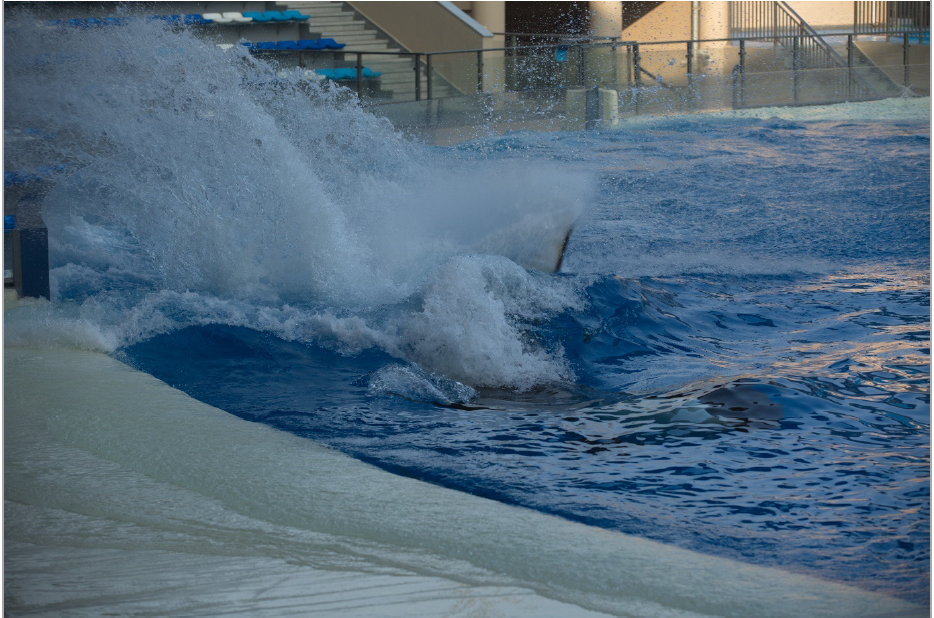 photo prise le 17/12/2018, © Ingrid N. Visser
photo prise le 17/12/2018, © Ingrid N. Visser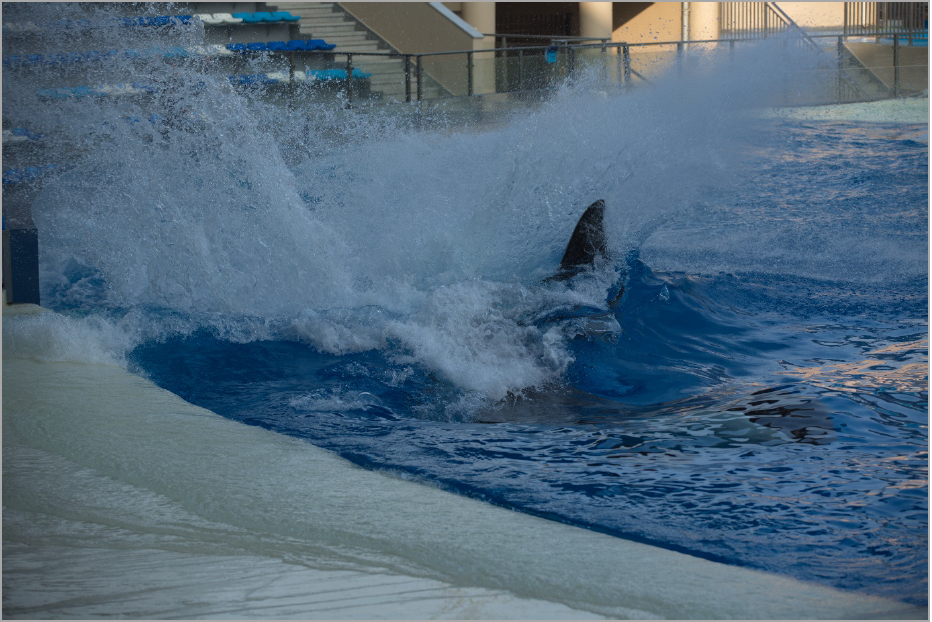 photo prise le 17/12/2018, © Ingrid N. Visser
photo prise le 17/12/2018, © Ingrid N. Visser
Orque sur le flanc en train d’éclabousser le public avec sa queue, au Shanghai Haichang Ocean Park, Shanghai, Chine.
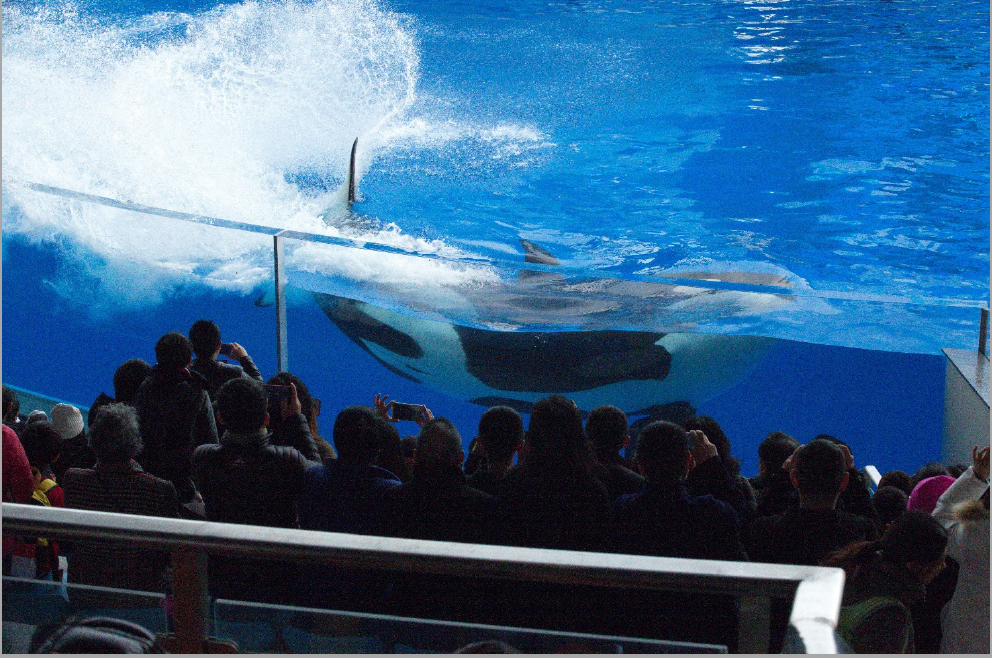 Orque sur le flanc en train d’éclabousser le public avec sa queue, au Shanghai Haichang Ocean Park, Shanghai, Chine (photo prise le 23/12/2018, © Ingrid N. Visser).
Orque sur le flanc en train d’éclabousser le public avec sa queue, au Shanghai Haichang Ocean Park, Shanghai, Chine (photo prise le 23/12/2018, © Ingrid N. Visser). L’une des grosses vagues éclaboussant le public, générées par les mouvements de queue de l’orque, au Shanghai Haichang Ocean Park, Shanghai, Chine (capture d’écran d’une vidéo prise le 23/12/2018, © Ingrid N. Visser).
L’une des grosses vagues éclaboussant le public, générées par les mouvements de queue de l’orque, au Shanghai Haichang Ocean Park, Shanghai, Chine (capture d’écran d’une vidéo prise le 23/12/2018, © Ingrid N. Visser).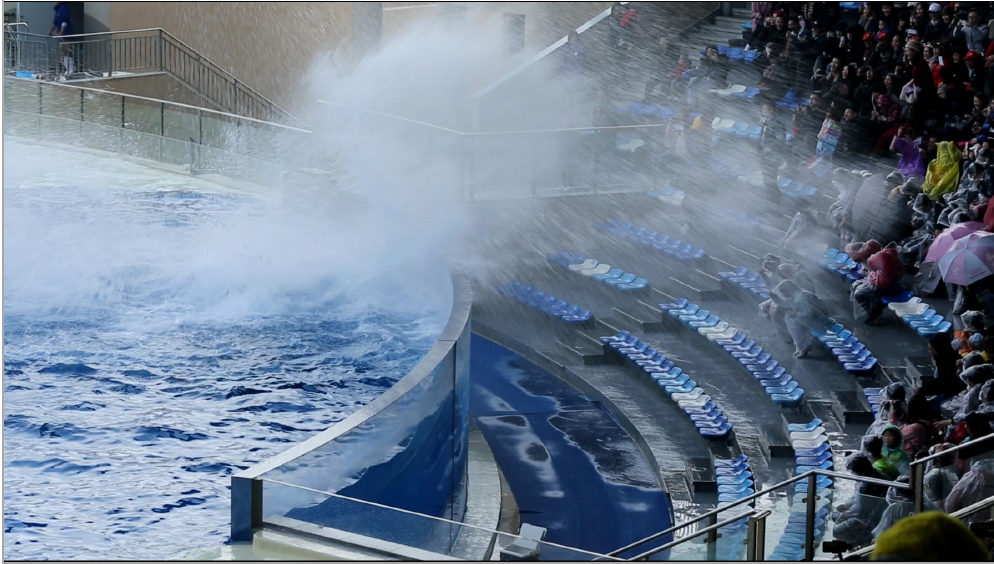 Une autre grosse vague éclaboussant le public au Shanghai Haichang Ocean Park, Shanghai, Chine (capture d’écran d’une vidéo prise le 23/12/2018, © Ingrid N. Visser).
Une autre grosse vague éclaboussant le public au Shanghai Haichang Ocean Park, Shanghai, Chine (capture d’écran d’une vidéo prise le 23/12/2018, © Ingrid N. Visser).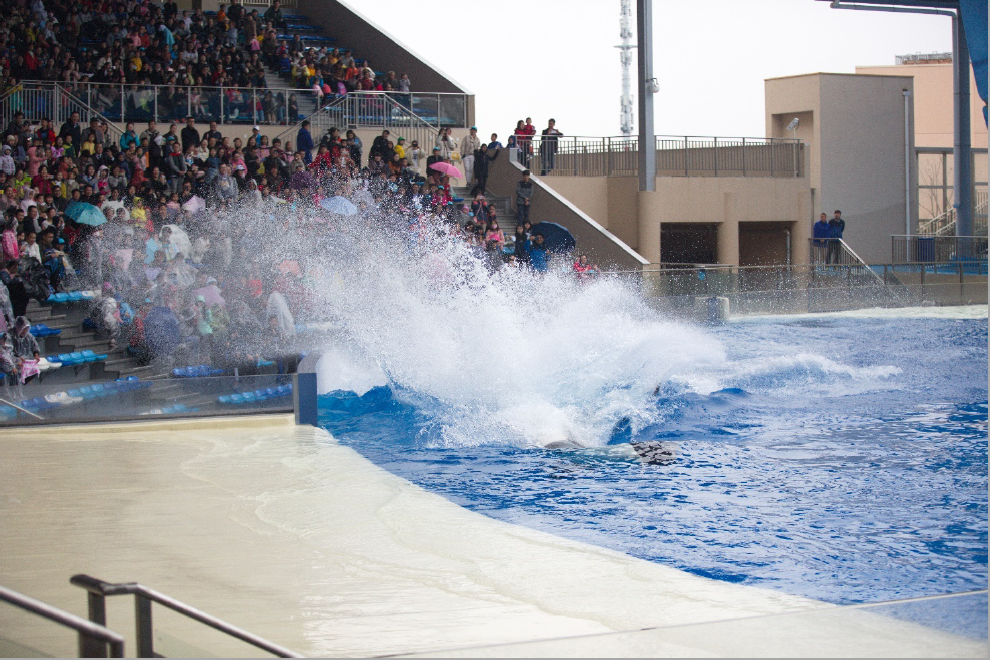 Certains spectateurs s’arment de parapluies afin de s’abriter partiellement des grands éclaboussements générés par l’orque au Shanghai Haichang Ocean Park, Shanghai, Chine (photo prise le 4/4/2019, © Ingrid N. Visser).
Certains spectateurs s’arment de parapluies afin de s’abriter partiellement des grands éclaboussements générés par l’orque au Shanghai Haichang Ocean Park, Shanghai, Chine (photo prise le 4/4/2019, © Ingrid N. Visser).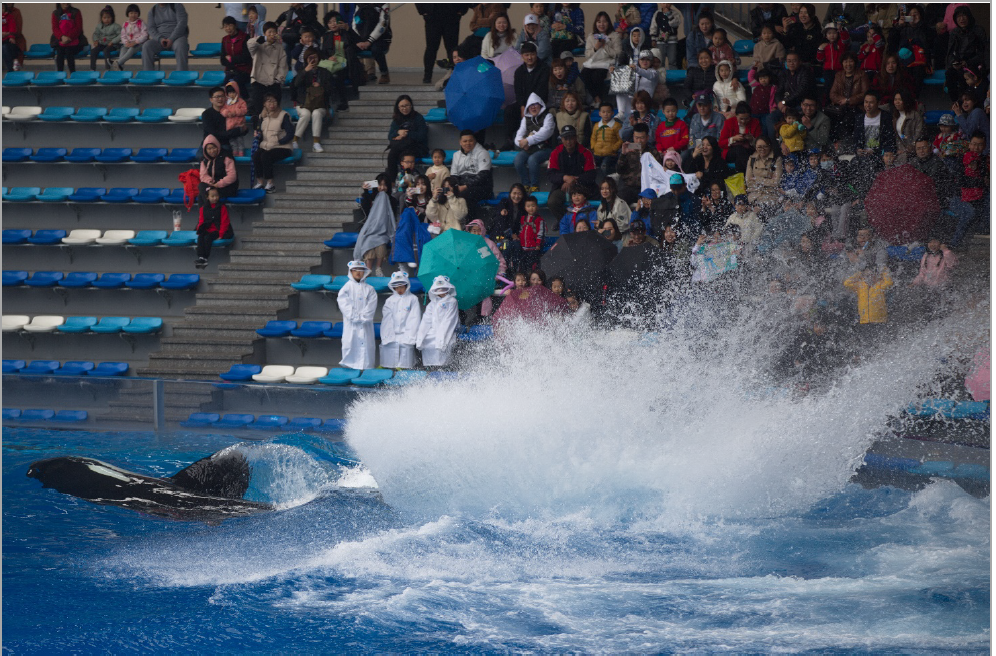 Trois enfants (en imperméables blancs) dans la zone d’éclaboussement générée par l’orque (notez également la présence de parapluies dans le public), au Shanghai Haichang Ocean Park, Shanghai, Chine (photo prise le 4/4/2019, © Ingrid N. Visser).
Trois enfants (en imperméables blancs) dans la zone d’éclaboussement générée par l’orque (notez également la présence de parapluies dans le public), au Shanghai Haichang Ocean Park, Shanghai, Chine (photo prise le 4/4/2019, © Ingrid N. Visser).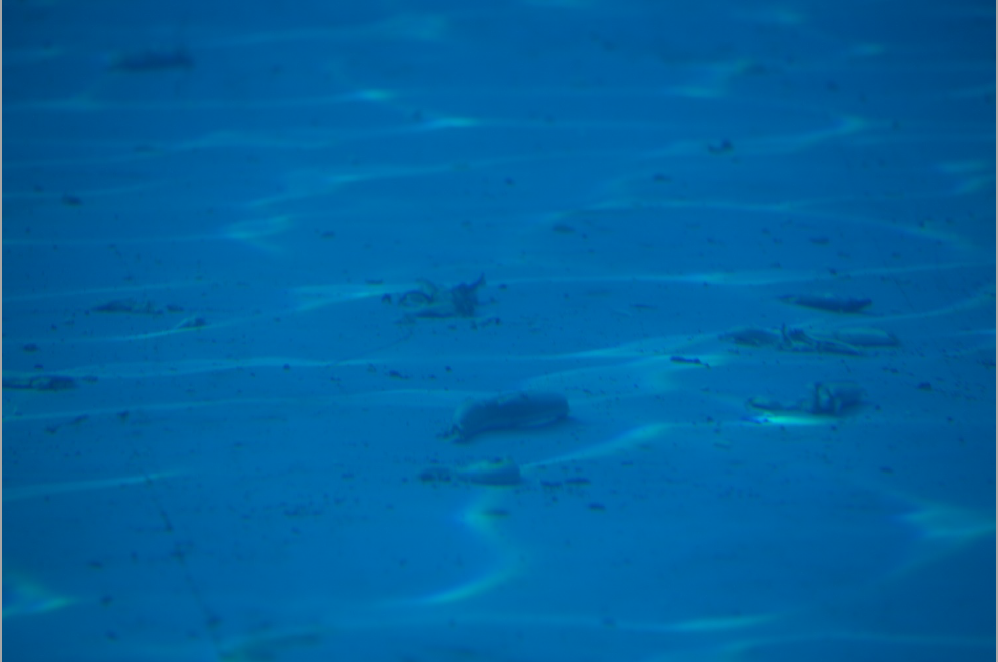 Poissons en décomposition et morceaux de poisson au fond d’un des bassins des orques, au Shanghai Haichang Ocean Park, Shanghai, Chine (photo prise le 17/12/2018, © Ingrid N. Visser).
Poissons en décomposition et morceaux de poisson au fond d’un des bassins des orques, au Shanghai Haichang Ocean Park, Shanghai, Chine (photo prise le 17/12/2018, © Ingrid N. Visser).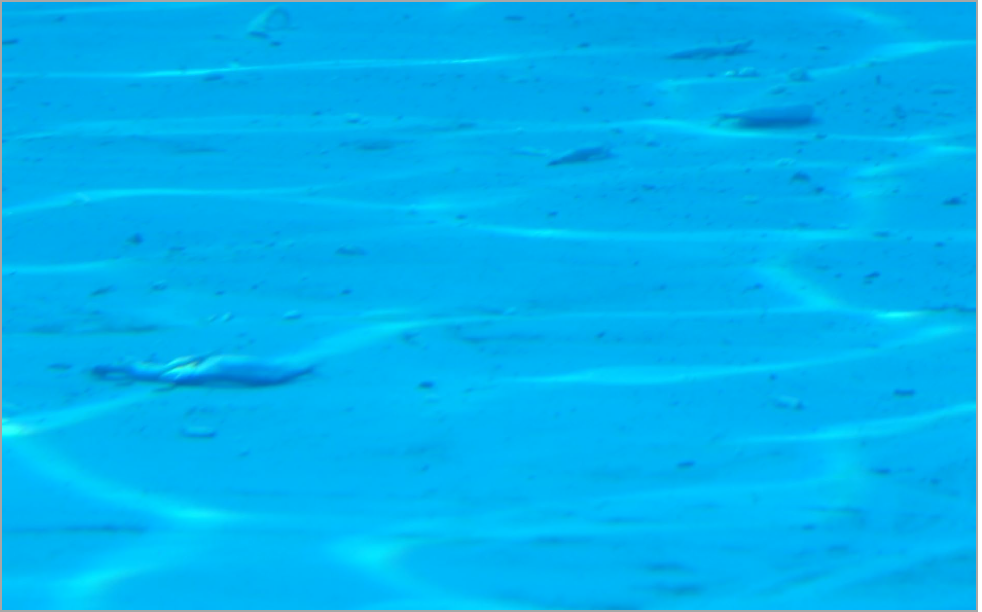 Poissons en décomposition et morceaux de poisson au fond d’un des bassins des orques, au Shanghai Haichang Ocean Park, Shanghai, Chine (capture d’écran d’une vidéo prise le 17/12/2018). © Ingrid N. Visser).
Poissons en décomposition et morceaux de poisson au fond d’un des bassins des orques, au Shanghai Haichang Ocean Park, Shanghai, Chine (capture d’écran d’une vidéo prise le 17/12/2018). © Ingrid N. Visser).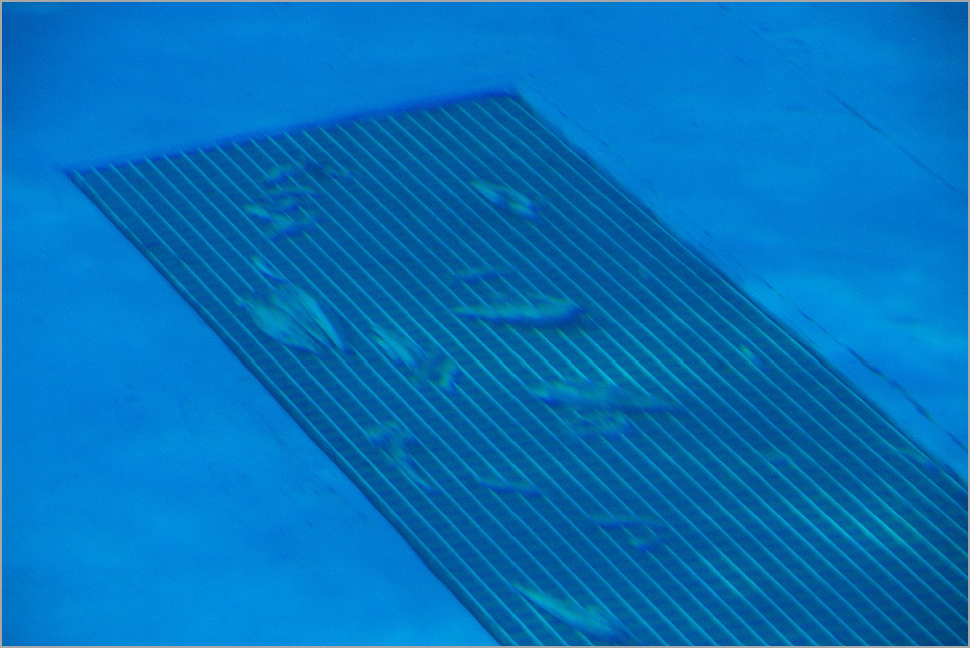 Poissons en décomposition et morceaux de poisson au fond d’un des bassins des orques, au Shanghai Haichang Ocean Park, Shanghai, Chine (photo prise le 18/12/2018). © Ingrid N. Visser).
Poissons en décomposition et morceaux de poisson au fond d’un des bassins des orques, au Shanghai Haichang Ocean Park, Shanghai, Chine (photo prise le 18/12/2018). © Ingrid N. Visser).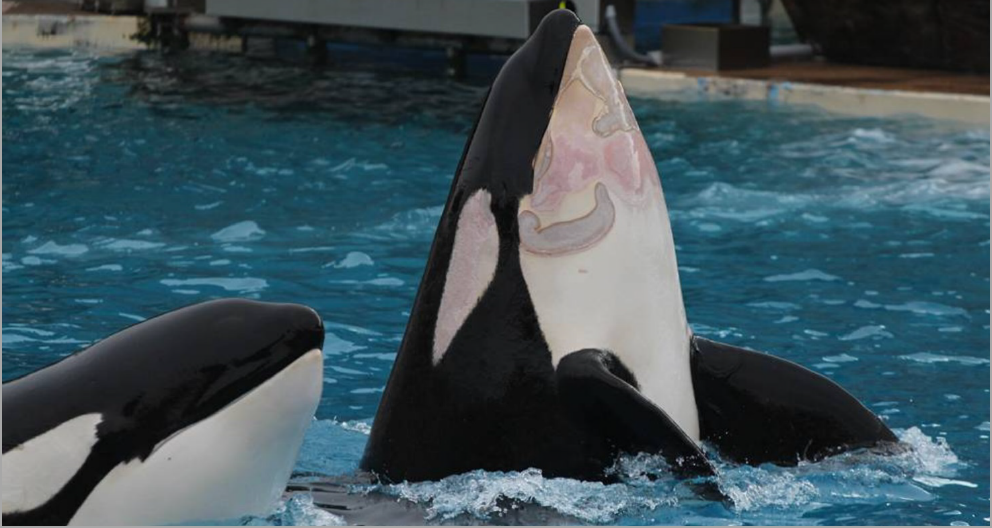 Photo prise autour du 6/8/2017 par hunter.d.photography au SeaWorld de San Diego, Californie, USA.
Photo prise autour du 6/8/2017 par hunter.d.photography au SeaWorld de San Diego, Californie, USA.
Kasatka, orque femelle née dans la nature (à droite), victime d’un agent pathogène dont le nom n’a pas été divulgué. Comme on le voit sur l’image, ce pathogène cause de vastes lésions sur l’ensemble de son corps. Soulignons le fait qu’au cours de cette épidémie, Kasatka est détenue en compagnie d’une autre orque.
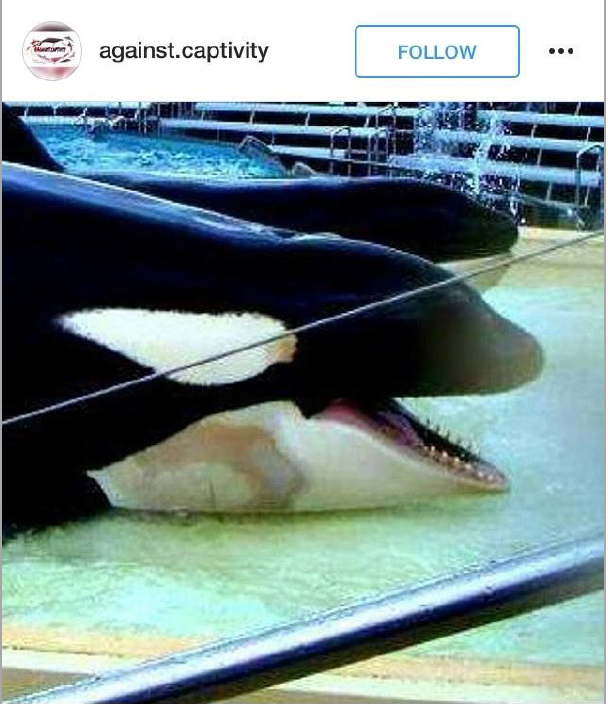 Kasatka, victime du même agent pathogène, peut-être à un stade plus précoce (étant donné qu’on ignore la date de la photo ainsi que son auteur), au SeaWorld de San Diego, Californie, USA.
Kasatka, victime du même agent pathogène, peut-être à un stade plus précoce (étant donné qu’on ignore la date de la photo ainsi que son auteur), au SeaWorld de San Diego, Californie, USA.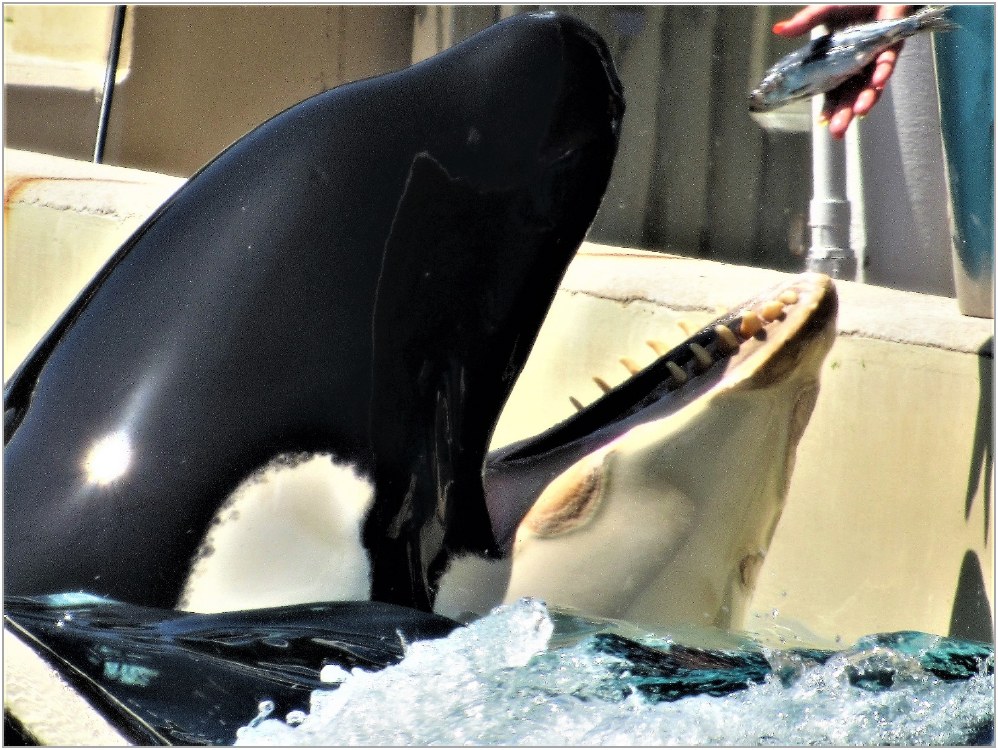 Photo prise autour du 16/6/2017 par un lanceur d’alerte au SeaWorld de San Diego, Californie, USA.
Photo prise autour du 16/6/2017 par un lanceur d’alerte au SeaWorld de San Diego, Californie, USA.
Kasatka (également en gros plan, ci-dessous), victime d’un agent pathogène dont le nom n’a pas été divulgué. Comme on le voit sur l’image, ce pathogène cause des lésions étendues sur l’ensemble de son corps.
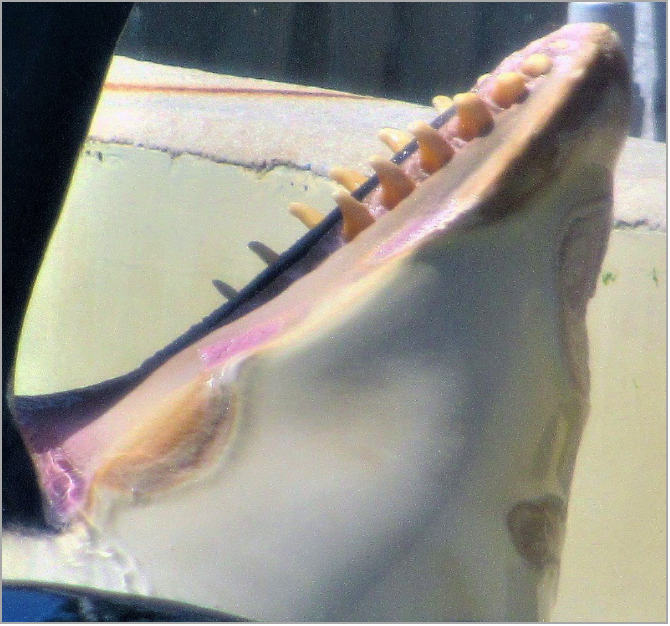 Photo prise autour du 16/6/2017 par un lanceur d’alerte au SeaWorld de San Diego, Californie, USA.
Photo prise autour du 16/6/2017 par un lanceur d’alerte au SeaWorld de San Diego, Californie, USA.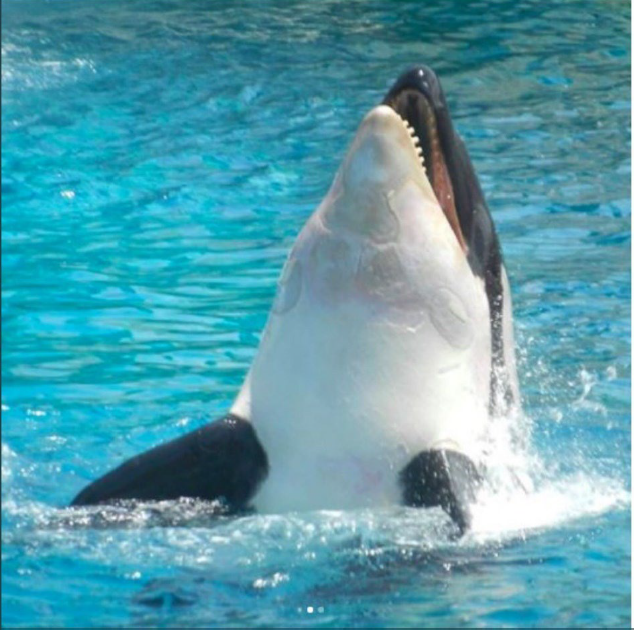
Kasatka, photo postée en ligne le 8/8/2017 par « seaworldtruthteam » (la date à laquelle la photo a été prise n’est pas claire). Cette publication a paru une semaine avant que Kasatka ne soit euthanasiée par SeaWorld. L’entreprise a déclaré que l’orque était victime d’un agent pathogène résistant aux médicaments et non traitable (le nom de cet agent pathogène n’a pas été divulgué).
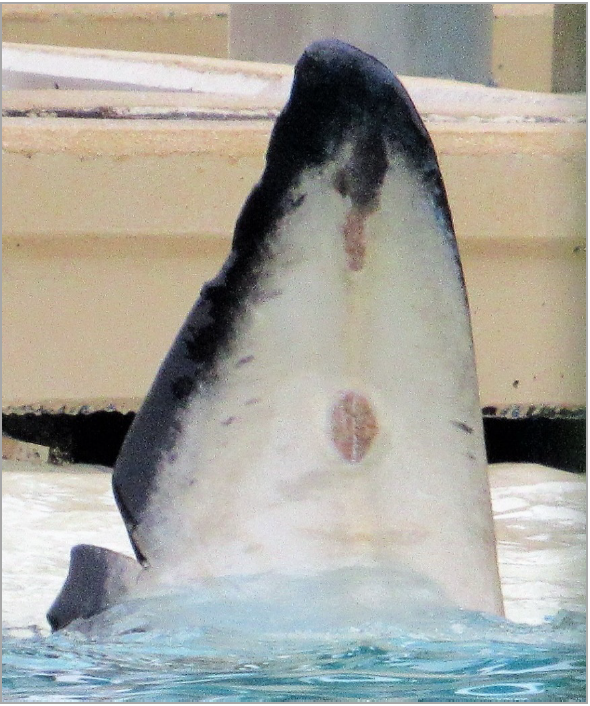
Gros plan du côté droit de la nageoire caudale de Kasatka, présentant les « traces » des piqûres du traitement du pathogène dont le nom n’a pas été divulgué. Notez la présence de lésions ouvertes le long des axes veineux au centre de la nageoire et près de son extrémité. Photo prise autour du 16/6/2017 par un lanceur d’alerte au SeaWorld de San Diego, Californie, USA.
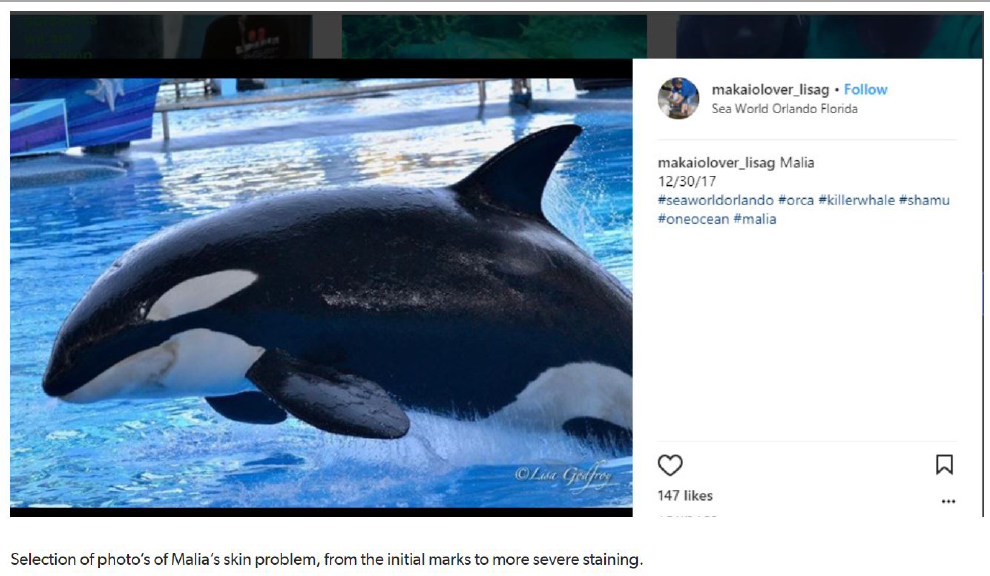
Une orque femelle (née en captivité) connue sous le nom de Malia, victime d’un agent pathogène dont le nom n’a pas été divulgué. Comme on le voit sur l’image, ce pathogène entraîne une large décoloration de la peau ainsi que quelques lésions ouvertes. Photo postée en ligne le 30/12/2017 par « makaiolover_lisag », SeaWorld d’Orlando, Floride, USA.
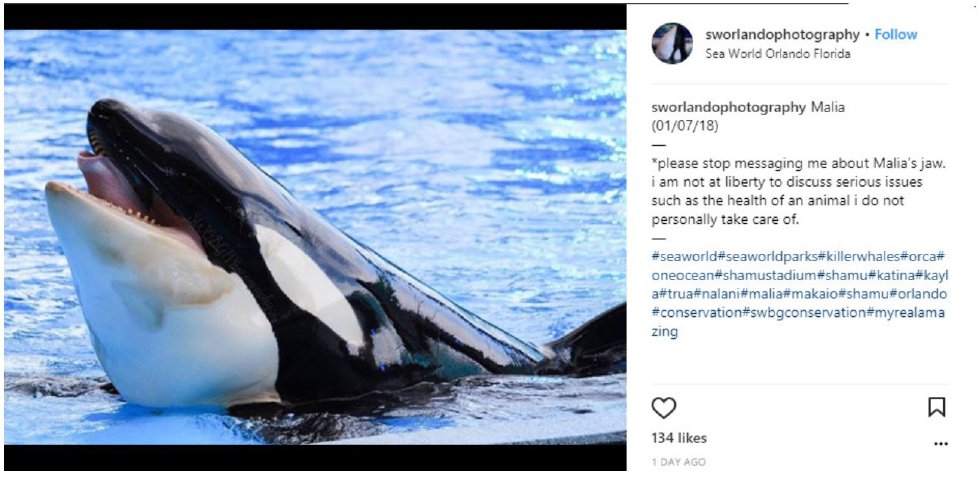
Prise une semaine plus tard, cette photo de Malia atteste que la décoloration de la peau s’étend sur la zone du menton. Un examen attentif montre que ce phénomène affecte également son côté droit. Photo postée en ligne le 7/1/2018 par « sworlandophotography », SeaWorld d’Orlando, Floride, USA.
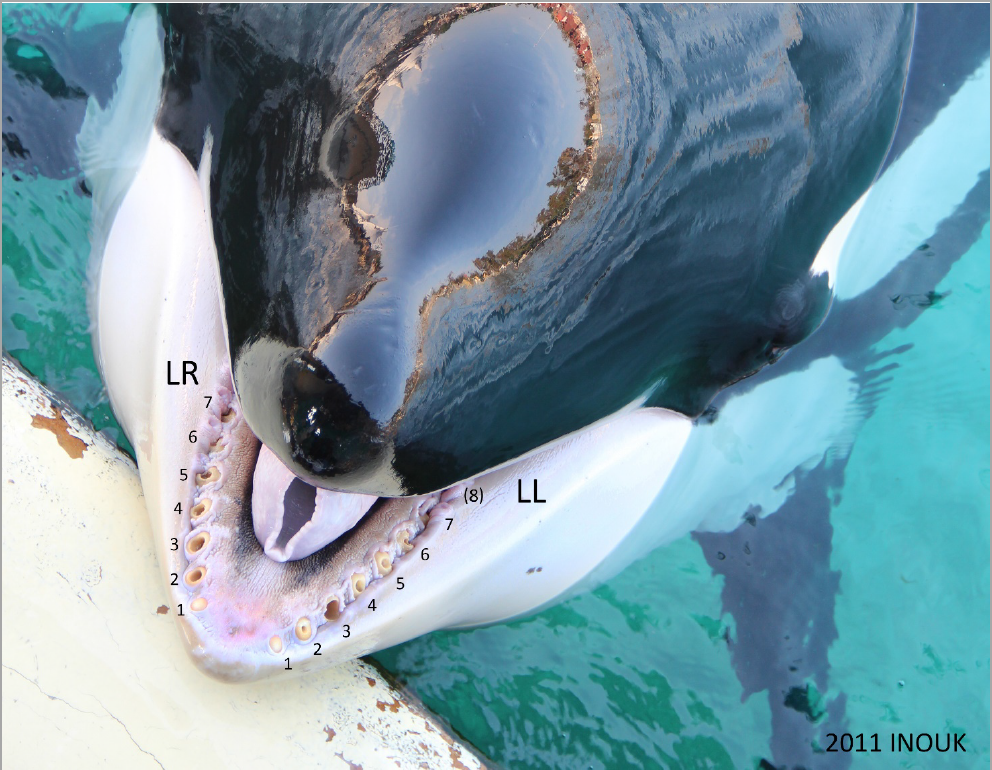
Inouk, orque mâle adulte détenue en France. Il fait partie des animaux qui auraient été envoyés en Chine. On constate que toutes ses dents sont usées jusqu’aux gencives et qu’elles ont toutes été percées pour exposer la pulpe dentaire. Les documents internes indiquent qu’Inouk est souvent sujet aux infections (voir note 22).
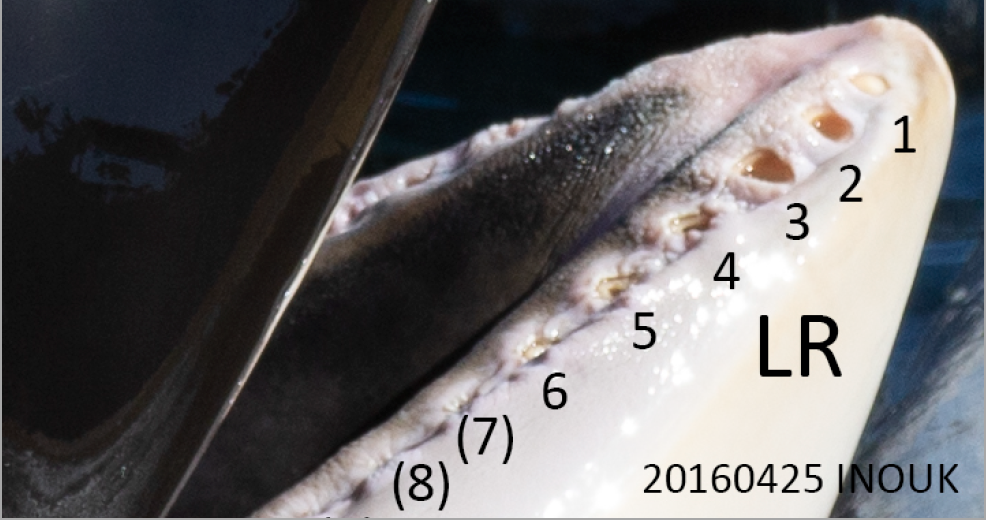
Inouk, orque mâle adulte détenue en France. Il fait partie des animaux qui auraient été envoyés en Chine. On constate que toutes ses dents sont usées jusqu’aux gencives et qu’elles ont toutes été percées pour exposer la pulpe dentaire. Les documents internes indiquent qu’Inouk est souvent sujet aux infections (voir note 22).
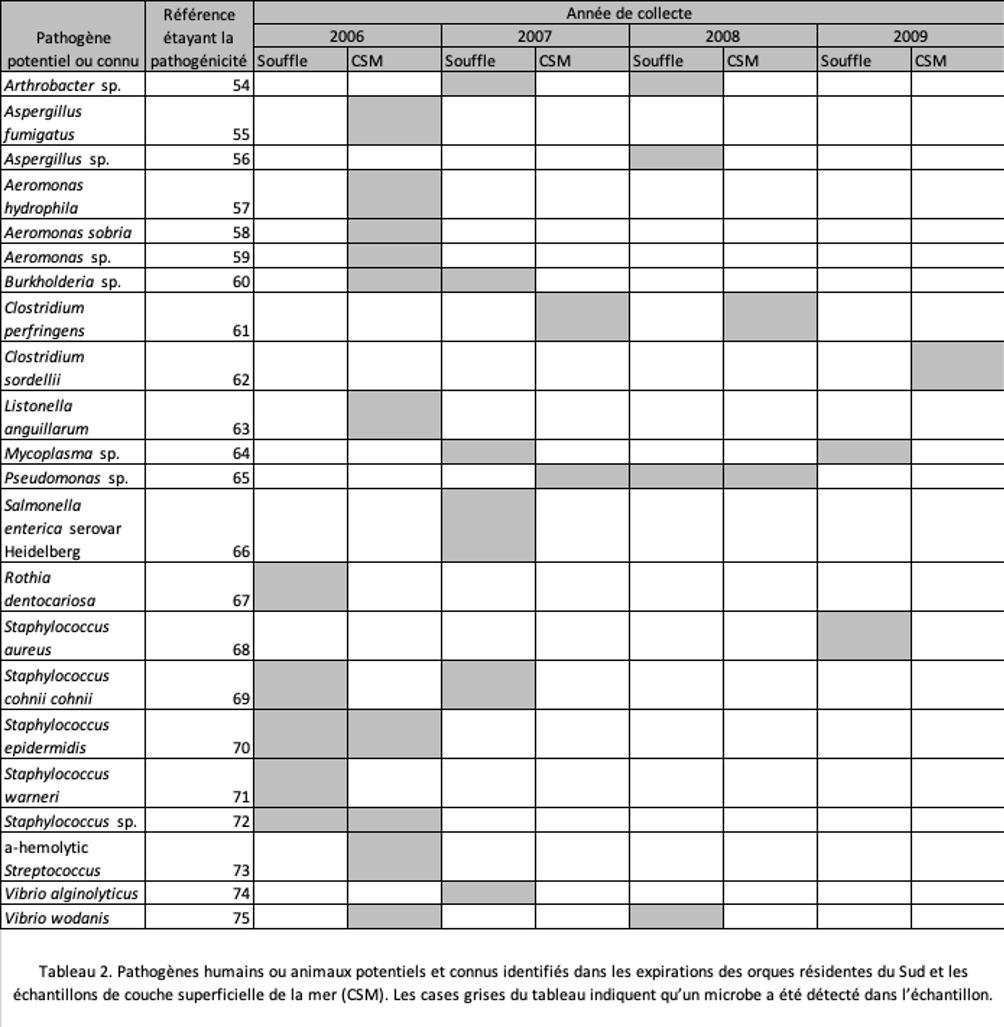 Source : Raverty, S. A., Rhodes, L. D., Zabek, E., Eshghi, A., Cameron, C. E., Hanson, M. B. et Schroeder, J. P. (2017), « Respiratory microbiome of endangered Southern Resident killer whales and microbiota of surrounding sea surface microlayer in the East
Source : Raverty, S. A., Rhodes, L. D., Zabek, E., Eshghi, A., Cameron, C. E., Hanson, M. B. et Schroeder, J. P. (2017), « Respiratory microbiome of endangered Southern Resident killer whales and microbiota of surrounding sea surface microlayer in the East
Notes:
1. https://web.archive.org/web/20…
2. Mihindukulasuriya, K. A., Wu, G., St. Leger, J., Nordhausen, R. W. et Wang, D., 2008, « Identification of a novel coronavirus from a beluga whale by using a panviral microarray », Journal of Virology, 82 : 5084 – 5088,
3. Woo, P. C. Y., Lau, S. K. P., Lam, C. S. F., Tsang, A. K. L., Hui, S. W., Fan, R. Y.Y., Martelli, P. et Yuen, K. Y. (2014), « Discovery of a novel bottlenose dolphin coronavirus reveals a distinct species of marine mammal coronavirus in Gammacoronavirus », Journal of Virology, 88 (2) : 1318 – 1331.
4. https://one-voice.fr/news/s…
5. https://www.nationalgeographic…
6. Voir le rapport (publié par la Cour) de la Dre Ingrid N. Visser concernant une orque captive détenue au Seaquarium de Miami, et faisant référence à un certain nombre d’agents pathogènes résistants aux médicaments : les « super bugs » Staphylococcus aureus (MRSA) (résistant à la méthicilline S. aureus), Staphylococcus sp. (CoNS, coagulase négative), Escherichia coli sp. #2 (résistant). Cas 1 : 15-cv-22692-UU, Florida Southern District Docket, 2016. En outre, plusieurs décès récents d’orques survenus à SeaWorld sont liés à des agents pathogènes résistants aux médicaments. Cf. par exemple le cas de l’orque femelle Unna : https://slate.com/news-and-pol…
7. https://www.thedodo.com/seawor…
8. Cf. l’article de presse où il est écrit que SeaWorld n’a pas publié le rapport d’autopsie de l’orque figurant dans le documentaire Blackfish : https://web.archive.org/web/20…
9. Rally, H. D., Baur, D. C., McFeeley, M. (2018), « Looking behind the Curtain: Achieving Disclosure of Medical and Scientific Information for Cetaceans in Captivity through Voluntary Compliance and Federal Enforcement », Animal Law. Lewis & Clark Law School, 24 : 303.
10. https://web.archive.org/web/20…
11. https://web.archive.org/save/h…
12. Rozanova, E. I., Alekseev, A. Y., Abramov, A. V., Rassadkin, Y. N. et Shestopalov, A. M. (2007), « Death of the killer whale Orsinus [sic] orca from bacterial pneumonia in 2003 », Russian Journal of Marine Biology, 33 (5) : 321-323.
13. Kielty, J. (2011), Marine Mammal Inventory Report (Deficiencies), St Pete Beach, Floride, USA, The Orca Project Corp (rapport non publié, disponible sur : https://theorcaproject.wordpress.com/2011/03/18/noaa-nmfs-marine-mammal-inventory-report-deficiencies/), 25 pages.
14. Ridgway, S. H. (1979), « Reported causes of death of captive killer whales (Orcinus orca) », Journal of Wildlife Diseases,
15 (1) : 99-104. 15. Buck, C., Paulino, G. P., Medina, D. J., Hsiung, G. D., Campbell, T. W. et Walsh, M. T. (1993), « Isolation of St. Louis encephalitis virus from a killer whale », Clinical and Diagnostic Virology, 1 : 109-112.
Jett, J., Ventre, J., Vail, C. et Dodson, L. (2012), « Evidence of lethal mosquito transmitted viral disease in captive Orcinus orca », 4e Conférence sur la santé des mammifères marins, Mote Marine Laboratory and Aquarium, Sarasota, Floride. 5.
Jett, J. et Ventre, J. M. (2012), « Orca (Orcinus orca) captivity and vulnerability to mosquito-transmitted viruses », Journal of Marine Animals and Their Ecology, 5 (2) : 9-16.
St. Leger, J., Wu, G., Anderson, M., Dalton, L., Nilson, E. et Wang, D. (2011), « West Nile Virus infection in killer whale, Texas, USA, 2007 », Emerging Infectious Diseases, 17 (8) : 1531-1533.
16. Marino, L., Rose, N. A., Visser, I. N., Rally, H. D., Ferdowsian, H. R. et Slootsky, V. (2019), « The harmful effects of captivity and chronic stress on the well-being of orcas (Orcinus orca) », Journal of Veterinary Behavior : https://doi.org/10.1016/j.jveb.2019.05.005.
17. https://web.archive.org/web/20…
18. https://ghss.georgetown.edu/ih…
19. Potter, S. L. (2013), Antimicrobial resistance in Orcinus orca scat: Using marine sentinels as indicators of pharmaceutical pollution in the Salish Sea, thèse de Master, p. 125, Evergreen State College.
20. https://www.scmp.com/news/chin…
21. Raverty, S. A., Rhodes, L. D., Zabek, E., Eshghi, A., Cameron, C. E., Hanson, M. B. et Schroeder, J. P. (2017), « Respiratory microbiome of endangered Southern Resident killer whales and microbiota of surrounding sea surface microlayer in the Eastern North Pacific », Scientific Reports, 394 : 1-12.
22. Visser, I. N., Jett, J. et Ventre, J. (2019), INOUK – Captive 20-year-old male orca, with chronic and extensive tooth damage, Rapport préparé pour One Voice (www.one-voice.fr), mars 2019, 25 pages.
23. https://web.archive.org/web/20…
24. https://www.worldanimalprotect…
25. http://chinacetaceanalliance.o…